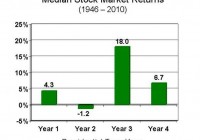How Diversifying Can Help You Manage Market Mayhem
Summary Diversification is not simply about holding more assets. It is about paying attention to how the different parts of your portfolio work together. At its most basic, you have three components: stocks, bonds and cash. You may want to hold a blend of all three, depending on your goals. Four traits adding flavor to a balanced portfolio include quality, geography, sectors and styles and size. The recent market volatility, while not unexpected , has certainly been hard for any investor to digest. If you are feeling a tad queasy, you aren’t alone. It’s an apt moment to pause and remind ourselves of the importance of diversification to help your portfolio ride through market turmoil. What is Proper Diversification? While attempting to teach my youngest daughter about nutrition over the summer, I pulled up the nutrition wheel . As I showed her the various food groups, I was reminded of a diversified portfolio with all its asset classes. Arguably the most overused word in investment jargon, diversification is not simply about holding more assets. It is about paying attention to how the different parts of your portfolio work together. It’s part art and part science, like so many things in life, and takes some careful thought to make the right choices. Think of it like maintaining a balanced diet – one food isn’t going to give you all the nutrition you need. Asset Classes as Food Asset classes are your basic food groups – carbs, proteins and vegetables. As with food, each asset plays a different role. At its most basic, you have three components: stocks, bonds and cash. Stocks are generally riskier than bonds, but you can potentially see greater gains over time. When stocks decline, bonds have generally held up better and often delivered positive returns. And then there’s cash, which many investors use to preserve capital for a major expense, like college tuition. You may want to hold a blend of all three, depending on your goals. Simply a mix of individual company stocks and corporate and government bonds, however, may not give you everything you need to best manage risk and return. A balanced portfolio could also include a variety of nutrients and flavors. Four Traits of a Balanced Portfolio Quality For your bond portfolio, you’ll want to consider diversifying across credit quality – such as Treasuries, investment-grade and high yield – each of which has a unique risk/return profile. For stocks, you may want to focus on the quality of a company’s balance sheets and evaluate factors such as dividend growth, earnings or management. Geography It’s natural to have a home-country bias, and the U.S. is still one of the strongest markets in the world. But there’s no denying that we live in a global economy. There can be real benefits to expanding your geographic horizon to pursue opportunities in other regions and countries. Try to have a risk-balanced blend of investments across developed and emerging markets so you’re well positioned globally. Also, keep in mind that the value of the dollar against other currencies has become more important to your bottom line lately. So consider whether some currency-hedged exchange traded funds (ETFs) may help to protect your portfolio against sudden changes. Sectors And Styles Industries respond differently to different parts of the business cycle. For example, cyclical sectors, such as technology and discretionary consumer goods, generally benefit from economic upturns. On the other end, defensive sectors, such as food staples and utilities, are the last areas that people cut back on when times are tough. There are also certain styles of stocks to consider, such as value or momentum, and, for certain investors, some smart beta strategies may be an alternative to consider to help you access those styles. In short, cycles turn, so you probably want to make sure you’re not over-concentrated in one area. Size Everyone wishes they had invested in just the right tech company in the early 1980s, when the now-successful ones were just getting off the ground. But back then, who knew that personal computers would not only be in nearly every home like a TV, but might actually kick TVs to the curb? While it’s true that smaller companies can sometimes pay off big, they also carry higher risks. So you’ll want to consider a mix of small, medium and large companies. Many investors skew to the large side, unless you have the stomach for lots of ups and downs. Stay Diversified Until the End This may feel like a lot to manage, but it’s not as complicated as it seems. Many online resources and financial planners can break down your existing portfolio into a pie chart so you can see what slices you have. Then seek advice before making any changes. If you’re just getting started, internet tools can help you create a diversified core portfolio . Or consider a core allocation ETF , based upon your risk appetite and time horizon. As you approach your goals, you may need to reallocate your holdings. But that doesn’t mean that you should be less diversified. Make sure you always have an appropriately balanced diet of investments. This post originally appeared on the BlackRock Blog.
